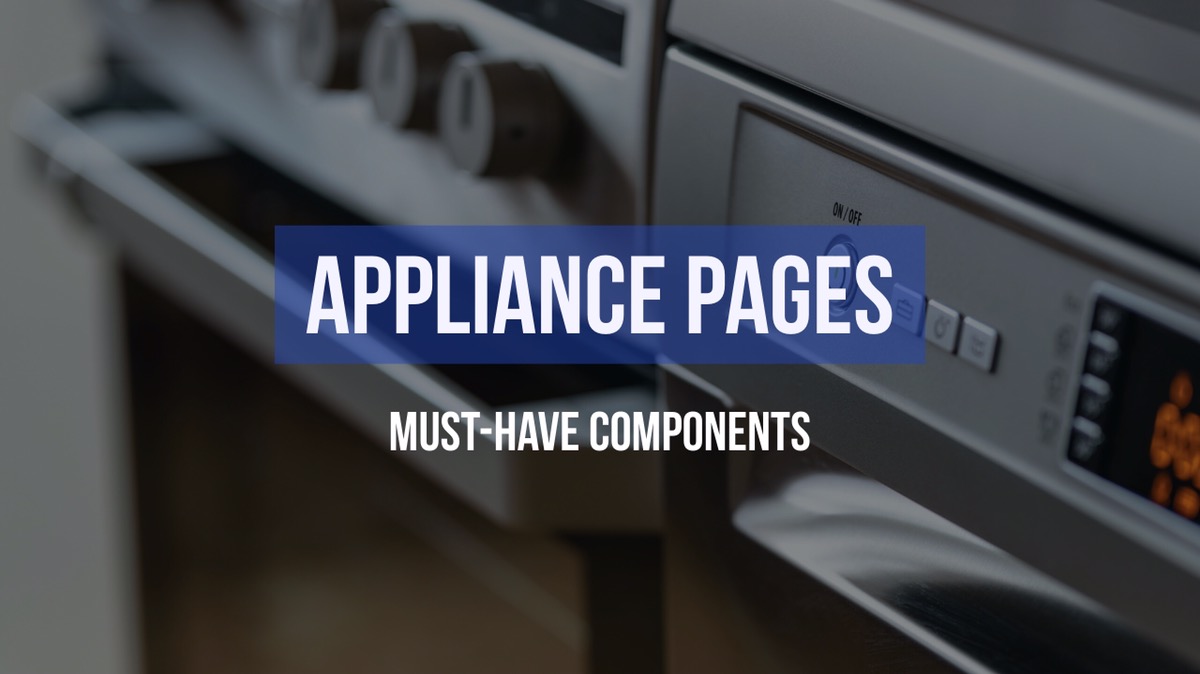Your appliance repair website needs to have individual pages for each appliance you repair. The typical list of appliance types are:
- Refrigerator repair
- Washer / Washing Machine repair
- Dryer repair
- Dishwasher repair
- Oven / Stove / Cooktop repair
- Microwave repair
If your appliance repair company also offers HVAC related services, you may include Furnace repair and Air Conditioner repair pages.
Not having appliance pages is a mistake
Some websites make the mistake of simply listing the types of appliances they repair, without creating dedicated pages for each appliance. This creates 2 problems. First, its harder for Google to rank the website for certain key words (like “refrigerator repair service”). And second – its harder for the website visitor to get more information about the specific appliance they need help with (which also causes them to have less trust in your service).
What to include on appliance pages?
The best way to decide what content to show on your appliance pages is to think like your website visitor.
This might sound strange, but stick with me for a couple of minutes. It will be worth your time.
Imagine a person, lets call her Helen. She woke up one morning and noticed that her fridge is not working (ie. leaking or not cold enough). Her husband has no clue, so she decides to look for help.
She goes to Google and types in “refrigerator repair service”.
What questions does your potential customer have?
- Who can fix my refrigerator? Will they come to my house? Or do I need to take it somewhere?
- Is there still warranty on my refrigerator? Should I call the factory?
- How much does it cost?
- How long does it take? When can they come to fix it?
- Is this reliable? Is there warranty on the repair service?
- Can we do it ourselves?
- Is it worth to repair? Or is it better to buy new?
Helen clicks on your website link. What does she see?
The information that she sees on your web page, should answer the questions that she has in her mind while she is searching.
Your customer should see the following:
- Clear headline that mentions the help she needs: “Refrigerator Repair Service”
- Brand of refrigerator – for example “Samsung” or “Dacor”
- Locations – for example “serving Toronto area” or ” in home service around Chicago”
- If possible, list common problems that happen with refrigerators
- Information that helps Helen trust you, like reviews from previous customers or your certifications
- Who are you – a couple of sentences about you and your company (make it personal)
- Your hours of operation and how fast can you help her (ie. next-day service or same-day service)
- Cost estimate, and if possible some savings coupons
- Local phone number and contact information
Essentially, your website content must answer specific questions in your prospect’s mind. Once all questions are answered, it’s easier for the prospect to take the action of contacting you.
Avoid too much information
Many appliance repair websites include too much information. The most common reason – is because they are trying to “trick” Google.
Very often I see websites that have lists of Cities and Brands followed by the words “appliance repair” appear hundreds of times on the page. This trick used to work in the past, 10 – 15 years ago. Nowadays, this type of content tells Google that your website is poorly built. And as a result, your search engine marketing efforts will be wasted.
Instead, focus on creating information for your website visitors.
Lastly, your pages need to be well designed
Your website information should be easy to read and professionally presented. In United States and Canada consumers have a higher sensitivity to design. When we see something that is not well designed aesthetically, then we tend to discount it’s value or stay away from it all together.
I have met many appliance repair business owners who spend over $10,000 each month into Adwords and Search Engine Optimization in order to drive visitors to their websites. Yet, they invested only $1000 or $2000 to build a basic website.
Instead, you should invest in good design. Good design will make your appliance repair website look professional and that will build trust for your customers.


